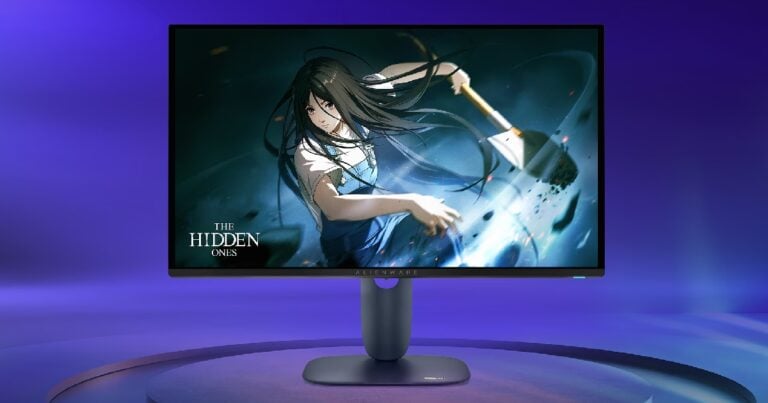Hands-on with the Alienware AW2725D QD-OLED Gaming Monitor, Samsung Galaxy Z Fold7, Star Wars Unlimited: Legends Of The Force and more.
Any longtime gamer would be able to tell you that when it comes to displays, OLED reigns supreme. With truer black representation and a colour palate that is richer overall, gaming with an OLED panel often feels like a transformative experience that’s difficult to turn back from. The only problem with the technology is that investment often requires pretty deep pockets, and that’s precisely what makes the Alienware AW2725D such an appealing proposition. Priced at $799 via the Dell Store, it’s not only one of the most affordable QD-OLED monitors in the market, it’s also able to deliver in spades.
When it comes to aesthetics, Alienware has kept things mercifully simple here. Aside from an illuminated Alienware logo at the rear, you’re not going to find any excessively flashing lighting or quirky ‘gamer’ design choices. Instead, the AW2725D embraces a more minimalistic approach with rounded features for both the stand and base. That’s perfect for anybody not wanting a statement piece while still being able to deliver the goods like adjustable height and a screen capable of both swivelling and pivoting for better ergonomics.
The monitor also does away with the more traditional black colourway in favour of what Alienware is dubbing Interstellar Indigo. That choice may not be for everyone, but I was personally a big fan of the unique finish, and thought it helped the unit stand out in a crowded marketplace while still popping slightly in amongst my setup,
I also appreciate the smaller, rounded square base at the bottom of the unit. There’s a decent amount of heft to keep things sturdy, but because it’s flat, you can still place all manner of knickknacks on top of it or around it as well.
When it comes to actual visual fidelity, the AW2725D positively shines. Packing a 26.7″ 1440p QD-OLED panel with a 280Hz refresh rate and 0.03ms response rate, you’re truly ready to handle almost any scenario thrown your way. Plus, thanks to the inclusion of two HDMI 2.1 ports (in addition to a Display Port and USB-C port that allows for the charging of some devices) at the bottom of the screen, even if you’re not focused on hardcore PC gaming, modern systems can easily be hooked up as well. That means I could connect both my Switch 2 and PS5 with zero issues – allowing the colourful landscapes of Donkey Kong Bananza to shined in a way that I wasn’t quite prepared for when compared to handheld performance, especially thanks to HDR which can hit up to up to 1,000 nits peak brightness. Likewise, the constantly shifting environments of Death Stranding 2 were also a treat– the AW2725D deftly able to transition between both bright and dark scenes without breaking a sweat and without losing
Love Film & TV?
Get your daily dose of everything happening in music, film and TV in Australia and abroad.
There’s honestly not a lot I don’t like about the AW2725D, but if I had to find one issue, it’s that despite being great for gaming, if you were hoping to use the monitor for multi-purpose productivity it may not be the best choice. That’s largely due to the static nature of email clients and Microsoft Office which make the unit more susceptible to OLED burn in. That said, Alienware has implemented an anti-burn-in AI algorithm to combat the issue. Either way, if all you want to do is just be able to hop onto the odd discord call or do some internet browsing, the AW2725D is more than up to the task.
At the end of the day I’ve been thoroughly impressed with the Alienware AW2725D. Sure the $799 asking price isn’t exactly ‘cheap’, but it still manages to offer some of the best bang for your buck right now. Pick one up and it’s hard to imagine you’ll be disappointed.
Also out now…
Samsung Galaxy Z Fold7
When it comes to Foldable phones, Samsung is certainly no stranger to the market. Having launched the Galaxy Fold back in 2019 the tech giant has made steady revisions to its line up in the years that followed. Now with the release of the Galaxy Z Fold7, Samsung hasn’t just made its best foldable yet, it’s also delivered one of the best foldables on the market.
It all starts with the design, which thankfully rectifies the Z Fold6’s biggest complaint: it’s awkwardness in the hand. Now measuring in at 72.8mm wide when folded, it’s a change that doesn’t sound huge in theory, but in practice easily makes the Z Fold7 feel more natural and comfortable. That meant hand cramps never became an issue and allowed messaging or typing emails to flow as easily as you’d expect. Complimenting the revised design is a fresh new finish as well, particularly with the Blue Shadow colourway I tested which really makes the device pop if you’re brave enough to use it sans case.
Much like the Pixel 9 Pro Fold last year, the Z Fold7 is shockingly thin, measuring in at a crazy 4.2mm when unfolded. It’s such an impressive feat that my USB-C charging cable was thicker than the shell out of the phone which is truly outlandish. The one downside to this achievement is that it makes the sizeable camera bump (containing a 200MP wide, 12MP ultra wide and 10MP telephoto system) to make itself even more obvious, and in turn become one of the biggest rockers when lying flat on a table without a case. That’s not a huge dealbreaker for me, but it will be for some, and it’s absolutely worth remembering whenever you place the phone on a more precarious surface.
And you’ll almost certainly want to protect your Z Fold7, because this phone will cost you a small fortune. Starting at an eye-watering $2899 for the 256GB model, this is by no means a cheap investment. That’s going to be a huge hurdle for many which is completely understandable. That said, if you are looking to blur the line between slab phone and tablet, the sheer functionality on offer here does provide a bit more justification, even though support for the S Pen has been booted which is disappointing and feels at odds with Samsung’s core selling points.
Multi-tasking, for example, can allow up to three separate windows when opened and that’s a huge win for productivity. I might be a specific use-case but I loved having my notes app open, while also utilising a webpage for fact checking and YouTube to deliver some relaxed vibes, all without breaking a sweat.
Likewise, thanks to the Snapdragon 8 Elite and the 8” AMOLED display when opened, gaming is a consistently smooth affair. Whether it was getting a handle on Marvel’s Mystic Mayhem, streaming via Xbox’s Cloud app, or even booting up beefier titles like Grand Theft Auto San Andreas via Netflix, the Z Fold7 handled it all without any noticeable throttling. Much like the Pixel 9 Pro Fold, emulation also works great here and is a great use for the extra screen real estate. Just be aware that if you are gaming for extended periods the device will naturally start to warm up and your battery will take a dive.
Finally there’s the cameras, and although your shots are never going to be able to compete with Samsung’s own flagship devices, the Z Fold7 does lead to better reliability than Google’s competitor, making it feel like a step forward in the right direction.
What that means is that if you can stomach the hefty price tag, the Samsung Galaxy Fold7 is a mighty impressive device that arguably makes it the new device to beat.
Star Wars Unlimited: Legends Of The Force
The card game scene has been heating up the last few years, but despite that Star Wars Unlimited has steadily been building fans with its pick-up-and-play gameplay and huge roster of characters to draw from.
Case in point, we now have Legends of the Force – a new set that instead of focusing on a particular period or setting, this time its drawing upon some of the series’ most popular Force users. Pre-built spotlight decks for example focus on Darth Maul and Qui-Gon Jinn and both showcase the series’ new addition – Force tokens.
Essentially these tokens allow certain cards to trigger special abilities that “use the force”. Take the Darth Maul set I had some to play around with, which allows you to deal 1 damage to 2 different units. It mightn’t seem like much but, combined with Maul’s unit card which deals an additional 2 damage, it’s a great opportunity to deliver chip damage over time. The twist? Force tokens can only be used once before they’re depleted, but can be re-gained via particular bases or action cards. While my time with the set has been brief, much like the rest of Star Wars Unlimited, Legends of the Force allows for some deeply strategic plays as you try to synergise cards to maximise damage from Force tokens.
If you’re in it for the collection, a fresh new batch of Jedi masters and Sith Lords should help sweeten the pot, making this a strong fifth outing for Star Wars Unlimited.
Wheel World (PS5, Xbox Series X/S, PS4, XBO, PC)
As a big fan of Messhof Games’ Nidhogg, I was hugely excited to see the team stretch its legs with this open world bicycle racing title. But even though Wheel World offers a lot of promise, it can’t quite reach the top of the podium.
The fundamentals are certainly in place. Playing as silent protagonist Kat, it’s your goal to obtain parts of a legendary bike by competing in various races to gradually boost your ride. Thankfully these races are fun to partake in and handle pretty well, especially on PS5 thanks to the DualSense.
But unfortunately as time goes on and you work your way through environments, the appeal to switch up components falters a little and the races start to lose a bit of their lustre. The pretty art style and soundtrack do help get things back on track, but occasionally sketchy performance (at least for now) lead to an overall unbalanced result.


































